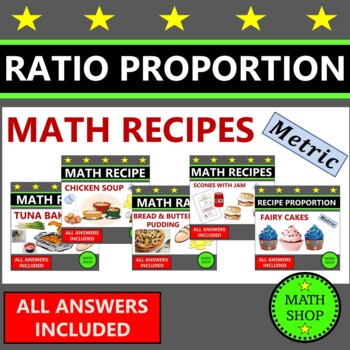Ratios and Proportions Recipes Metric Measurements Cup Cakes 6th Grade Math
Math Shop
290 Followers
Grade Levels
6th - 7th, Homeschool
Subjects
Resource Type
Standards
CCSS6.RP.A.1
CCSS6.RP.A.2
CCSS6.RP.A.3
CCSS6.RP.A.3a
CCSS7.RP.A.1
Formats Included
- Zip
Pages
18 worksheets plus recipes and answers
Math Shop
290 Followers
Products in this Bundle (5)
Also included in
- Ratio Proportion Measurement Money Fun ratio and proportion questions.These resource includes:✦ Student Worksheets. ✦ All answers.✽ These resources can be printed in black and white.♥ You may also like:Ratio Proportion ResourcesMetric Resources ☞ Visit Math Shop to see more of my resources.Price $17.00Original Price $24.00Save $7.00
- Ratios and Proportions Math Recipe Real Life Math 6th Grade Math WorksheetsMetric Measurements Cup Cakes and SconesUnits are metric.All answers are included.These worksheets can be used as practice questions, tests or homework.✦✦✦ See more ratio and proportion resources here. ✦✦✦☞ Visit Math Shop toPrice $17.00Original Price $24.00Save $7.00
Description
Ratios and Proportions Recipes Metric Measurements Cup Cakes 6th Grade Math
A bundle of 5 different resources with worksheets for 5 different recipes.
Recipes included are for tuna bake, chicken soup, scones, fairy cakes and bread and butter pudding.
Units are metric.
All answers are included.
These worksheets can be used as practice questions, tests or homework.
✦ Objectives:
To practice:
- Using metric units.
- Converting kg to grams and litres to ml.
- Using proportional relationships to solve multi-step ratio problems.
- Recognizing and representing proportional relationships between quantities.
- Using ratio and rate reasoning to solve real-world and mathematical problems.
- Understanding the concept of a unit rate in the context of a ratio relationship.
- Understanding the concept of a ratio to describe a ratio relationship between two quantities.
- Working with fractions and decimals.
✽ Directions:
Print out a set of worksheets for each student.
You can print in color or it will work just as well in black and white.
✦ Notes:
All answers are included, so you can easily mark students work.
Total Pages
18 worksheets plus recipes and answers
Answer Key
Included
Teaching Duration
3 hours
Report this resource to TPT
Reported resources will be reviewed by our team. Report this resource to let us know if this resource violates TPT’s content guidelines.
Standards
to see state-specific standards (only available in the US).
CCSS6.RP.A.1
Understand the concept of a ratio and use ratio language to describe a ratio relationship between two quantities. For example, “The ratio of wings to beaks in the bird house at the zoo was 2:1, because for every 2 wings there was 1 beak.” “For every vote candidate A received, candidate C received nearly three votes.”
CCSS6.RP.A.2
Understand the concept of a unit rate 𝘢/𝘣 associated with a ratio 𝘢:𝘣 with 𝘣 ≠ 0, and use rate language in the context of a ratio relationship. For example, “This recipe has a ratio of 3 cups of flour to 4 cups of sugar, so there is 3/4 cup of flour for each cup of sugar.” “We paid $75 for 15 hamburgers, which is a rate of $5 per hamburger.”
CCSS6.RP.A.3
Use ratio and rate reasoning to solve real-world and mathematical problems, e.g., by reasoning about tables of equivalent ratios, tape diagrams, double number line diagrams, or equations.
CCSS6.RP.A.3a
Make tables of equivalent ratios relating quantities with whole-number measurements, find missing values in the tables, and plot the pairs of values on the coordinate plane. Use tables to compare ratios.
CCSS7.RP.A.1
Compute unit rates associated with ratios of fractions, including ratios of lengths, areas and other quantities measured in like or different units. For example, if a person walks 1/2 mile in each 1/4 hour, compute the unit rate as the complex fraction ½/¼ miles per hour, equivalently 2 miles per hour.




